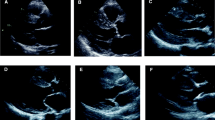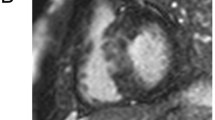Abstract
Purpose
To evaluate the capability of MRI to differentiate cardiac amyloidosis (CA), end-stage hypertrophic cardiomyopathy (HCM), and hypertensive heart disease (HHD), which are important etiologies of left ventricular hypertrophy (LVH) and heart failure.
Materials and methods
We enrolled 26 patients presenting with both LVH and heart failure: six with CA, nine with end-stage HCM, and 11 with HHD. Cardiac function, presence of pericardial or pleural effusion, and the extent and patterns of late gadolinium enhancement (LGE) were compared among the three diseases.
Results
Myocardial LGE was observed in all six CA patients, eight end-stage HCM patients, and six HHD patients. The number of LGE segments was significantly greater in CA than in HCM or HHD (p = 0.02 for both), and all patients with CA showed a global endocardial pattern of LGE. There were significant differences among CA, HCM, and HHD in ejection fraction and end-diastolic and end-systolic volume indices (p < 0.05 for all). Pericardial effusion was observed more frequently in CA than in HCM or HHD (p = 0.04 or 0.01, respectively).
Conclusion
MRI is valuable for distinguishing among CA, end-stage HCM, and HHD, all of which present with LVH and heart failure.



Similar content being viewed by others
References
Levy D, Garrison RJ, Savage DD, Kannel WB, Castelli WP. Prognostic implications of echocardiographically determined left ventricular mass in the Framingham Heart Study. N Engl J Med. 1990;322:1561–6.
Perugini E, Rapezzi C, Piva T, Leone O, Bacchi L, Riva L, et al. Non-invasive evaluation of cardiac amyloidosis by gadolinium cardiac magnetic resonance. Heart. 2006;92:343–9.
Falk RH. Cardiac amyloidosis: a treatable disease, often overlooked. Circulation. 2011;124:1079–85.
Elliott P, McKenna WJ. Hypertrophic cardiomyopathy. Lancet. 2004;363:1881–91.
Harris KM, Sipirito P, Maron MS, Zenovich AG, Formisano F, Lesser JR, et al. Prevalence, clinical profile, and significance of left ventricular remodeling in the end-stage phase of hypertrophic cardiomyopathy. Circulation. 2006;114:216–25.
Drazner MH. The progression of hypertensive heart disease. Circulation. 2011;123:327–34.
James MA, Saadeh AM, Jones JV. Wall stress and hypertension. J Cardiovasc Risk. 2000;3:187–90.
Rudolph A, Abdel-Aty H, Bohl S, Boye P, Zagrosek A, Dietz R, et al. Noninvasive detection of fibrosis applying contrast-enhanced cardiac magnetic resonance in different forms of left ventricular hypertrophy. J Am Coll Cardiol. 2009;53:284–91.
Sipola P, Magga J, Husso M, Jaaskelainen P, Peuhkurinen K, Kuusisto J. Cardiac MRI assessed left ventricular hypertrophy in differentiating hypertensive heart disease from hypertrophic cardiomyopathy attributable to a sarcomeric gene mutation. Eur Radiol. 2011;7:1383–9.
Puntmann VO, Jahnke C, Gebker R, Schnackenburg B, Fox KF, Fleck E, et al. Usefulness of magnetic resonance imaging to distinguish hypertensive and hypertrophic cardiomyopathy. Am J Cardiol. 2010;106:1016–22.
Maceria AM, Joshi J, Prasad SK, Moon JC, Perugini E, Harding I, et al. Cardiovascular magnetic resonance in cardiac amyloidosis. Circulation. 2005;111:186–93.
Alfakih K, Plein S, Thiele H, Jones T, Ridgway JP, Sivananthan MU. Normal human left and right ventricular dimensions for MRI as assessed by turbo gradient echo and steady-state free precession imaging sequences. J Magn Reson Imaging. 2003;17:323–9.
Maron MS. Clinical utility of cardiovascular magnetic resonance in hypertrophic cardiomyopathy. J Cardiovasc Magn Reson. 2012;14:13.
Efthimiadis GK, Giannakoulas G, Parharidou DG, Karvounis HI, Mochlas ST, Styliadis H, et al. Prevalence of systolic impairment in an unselected regional population with hypertrophic cardiomyopathy. Am J Cardiol. 2006;98:1272–96.
Mancia G, De Backer G, Dominiczak A, Cifkova R, Fagard R, Germano G, et al. 2007 ESH-ESC Practice guidelines for the management of arterial hypertension: ESH-ESC task force on the management of arterial hypertension. J Hypertens. 2007;25:1751–62.
Cerqueira MD, Weissman NJ, Dilsizian V, Jacobs AK, Kaul S, Laskey WK, et al. Standardized myocardial segmentation and nomenclature for tomographic imaging of the heart. A statement for healthcare professionals from the Cardiac Imaging Committee of the Council on Clinical Cardiology of the American Heart Association. Circulation. 2002;105:539–42.
Mahrholdt H, Wagner A, Judd RM, Sechtem U, Kim RJ. Delayed enhancement cardiovascular magnetic resonance assessment of non-ischaemic cardiomyopathies. Eur Heart J. 2005;26:1461–74.
Kim RJ, Wu E, Rafael A, Chen EL, Parker MA, Simonetti O, et al. The use of contrast-enhanced magnetic resonance imaging to identify reversible myocardial dysfunction. N Engl J Med. 2000;343:1445–53.
Hosch W, Kristen AV, Libicher M, Dengler TJ, Aulumann S, Heye T, et al. Late enhancement in cardiac amyloidosis: correlation of MRI enhancement pattern with histopathological findings. Amyloid. 2008;3:196–204.
Maron MS, Appelbaum E, Harrigan CJ, Buros J, Gibson CM, Hanna C, et al. Clinical profile and significance of delayed enhancement in hypertrophic cardiomyopathy. Circ Heart Fail. 2008;1:184–91.
Querejeta R, Varo N, Lopez B, Larman M, Artiñano E, Etayo JC, et al. Serum carboxy-terminal propeptide of procollagen type I is a marker of myocardial fibrosis in hypertensive heart disease. Circulation. 2000;101:1729–35.
Anderson K, Hennersdorf M, Cohnen M, Blondin D, Modder U, Poll LW. Myocardial delayed contrast enhancement in patients with arterial hypertension: initial results of cardiac MRI. Eur J Radiol. 2009;71:75–81.
Fattiri R, Rocchi G, Celletti F, Bertaccini P, Rapezzi C, Gavelli G. Contribution of magnetic resonance imaging in the differential diagnosis of cardiac amyloidosis and symmetric hypertrophic cardiomyopathy. Am Heart J. 1998;136:824–30.
Maron MS, Hauser TH, Dubrow E, Horst TA, Kissinger KV, et al. Right ventricular involvement in hypertrophic cardiomyopathy. Am J Cardiol. 2007;100:1293–8.
Cacoub P, Axler O, Dezuttere D, Hausfater P, Amoura Z, Watter S, et al. Amyloidosis and cardiac involvement. Ann Med Interne (Paris). 2000;151:611–7.
Berk JL. Pleural effusions in systemic amyloidosis. Curr Opin Pulm Med. 2005;11:324–8.
Biagini E, Coccolo F, Ferlito M, Perugini E, Rocchi G, Bacchi-Reggiani L, et al. Dilated-hypokinetic evolution of hypertrophic cardiomyopathy: prevalence, incidence, risk factors, and prognostic implications in pediatric and adult patients. J Am Coll Cardiol. 2005;46:1543–50.
Hosch W, Bock M, Libicher M, Ley S, Hegenbart U, Dengler TJ, et al. MR-relaxometry of myocardial tissue: significant elevation of T1 and T2 relaxation times in cardiac amyloidosis. Invest Radiology. 2007;42:636–42.
Kono AK, Yamada N, Higashi M, Kanzaki S, Hashimura H, Morita Y, et al. Dynamic late gadolinium enhancement simply quantified using myocardium to lumen signal ratio: normal range of ratio and diffuse abnormal enhancement of cardiac amyloidosis. J Magn Reson Imaging. 2011;34:50–5.
Conflict of interest
The authors declare that they have no conflicts of interest.
Author information
Authors and Affiliations
Corresponding author
About this article
Cite this article
Takeda, M., Amano, Y., Tachi, M. et al. MRI differentiation of cardiomyopathy showing left ventricular hypertrophy and heart failure: differentiation between cardiac amyloidosis, hypertrophic cardiomyopathy, and hypertensive heart disease. Jpn J Radiol 31, 693–700 (2013). https://doi.org/10.1007/s11604-013-0238-0
Received:
Accepted:
Published:
Issue Date:
DOI: https://doi.org/10.1007/s11604-013-0238-0




